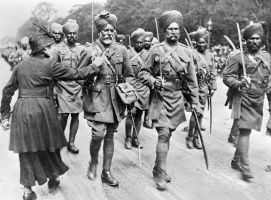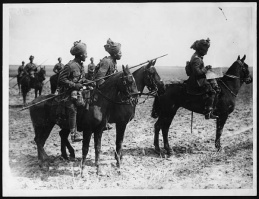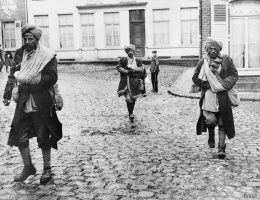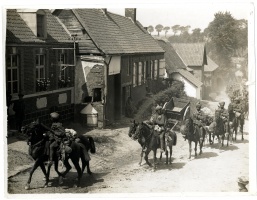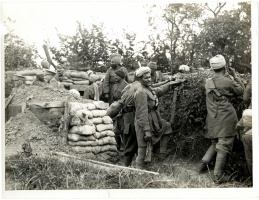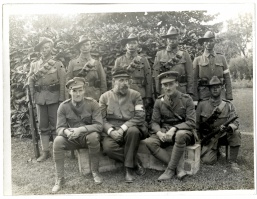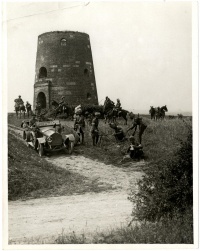The Indian Army in 1914 and the Formation of the Indian Expeditionary Force↑
The Indian army was conceived of as an auxiliary force to the British army. Its mission was to assist the latter in fighting “small wars”, either campaigns on the northwest frontier of India against the Baluch and Pashtun tribal groups, or colonial expeditions to conquer new territories or repress revolts. Its total strength in 1914 was 152,000, i.e., approximately two-thirds of the strength of the British army (250,000), but it was devoid of heavy artillery, and its training emphasized combat in open terrain against a mobile enemy not equipped with artillery. It was definitely not meant to take part in a European war. With the growth of tensions in Europe, however, a plan was drawn up in 1911 that envisaged sending Indian troops to Europe, but it was shelved at the request of the British government. When, following the disastrous Mons retreat in early August 1914, the British Expeditionary Force to France and Belgium found itself seriously undermanned, it was decided to call on the Indian army, the only available imperial reserve force. An Indian Expeditionary Force (IEF), consisting of two infantry divisions (Meerut and Lahore) and two cavalry brigades (Ambala and Secunderabad), was hastily assembled and dispatched to Marseilles, where it disembarked on 26 September. These units formed, for operational purposes, an Indian Corps, some 45,000 strong (28,500 Indian and 16,500 British) and under the command of General James Willcocks (1857-1926), which was part of Douglas Haig’s (1861-1928) British 1st Army.
Holding the Line↑
The Indian sepoys had to adjust quickly to the climate of Europe and to the use of new weapons, such as the Lee-Enfield Mark III gun and the Vickers machine-gun, but they lacked proper winter clothing when they were sent to the front at the end of October 1914 to take part in the First Battle of Ypres (25 October-15 November). The Indian Corps was ordered to hold a line seventeen kilometres long, i.e., one-third of the line held by the British 1st Army, and faced severe German attacks without proper artillery cover. The first two months of combat took a heavy toll on the Indians, who had to learn a form of combat they were unused to, and sustained great losses, including that of most of their experienced British officers. Their biggest trial came in the Givenchy sector on 19-20 December: four Indian brigades launched an attack against the German lines. They gained some ground, but, in the face of the German counter-attack, could not hold and had to be relieved by British troops. The High Command decided they were so exhausted that they had to be withdrawn from the front to recuperate.
Doubts and Controversies↑
At that time, serious doubts started to be voiced by some in British command, including Commander-in-Chief Sir John French (1852-1925) and 1st Army commander Douglas Haig, regarding the performance of the Indian soldiers and the value of their deployment. It was remarked that the incidence of self-inflicted wounds (mutilation of the hands) was higher in the Indian than in the British ranks, which was seen as a sign of poor morale and led to accusations of “cowardice” directed at the sepoys. Military historians have been divided in their opinions regarding the performance of the Indians. Jeremy Greenhut, an American military historian, largely echoing the views of the British High Command, was critical of their performance in an often-quoted article: he ascribed their failure to the difficulty soldiers coming from an agrarian country had in adapting to modern industrial warfare.[1] His views have recently been criticized by British military historian George Morton Jack, who claims that the Indians were learning the basics of trench warfare, like the soldiers of all the other armies, a process that was interrupted before it could be completed, which makes an objective judgment of their performance difficult.[2]
Towards Withdrawal↑
Whatever the doubts expressed by the British High Command, the Indian Corps was sent back into battle at the beginning of 1915 and took part in the battle of Neuve-Chapelle on 10-12 March 1915. It conquered some terrain against fierce German resistance, but had to withdraw due to insufficient artillery preparation. The Indian Corps took part in a few other battles: the second battle of Ypres (April 1915), and the battles of Aubers ridge (9 May) and Festubert (15-25 May). Its last intervention was in the battle of Loos (25 September-15 October 1915). At the end of October 1915, it was dissolved, having sustained total casualties of 22,000 (8,000 dead and disappeared; 14,000 wounded) and, at the end of December, the two infantry divisions (with 30,000 Indian and 4,500 British) left France for Mesopotamia, where they were immediately thrown into battle at Kut-el-Amara. 7,000 cavalry soldiers were left in France, as well as 6,000 auxiliaries. They were merged with Canadian cavalry to form a new Cavalry Corps. They remained in France until March 1918, rarely engaging in combat, and mostly used as labour to dig trenches and perform other work. In March 1918, they were dispatched to Egypt, where they joined Edmund Allenby’s (1861-1936) forces to take part in the Palestine campaign against the Turkish army.
An Uncertain Legacy↑
The despatch of Indian troops to Europe, in breach of the official British strategic doctrine, triggered an official protest by Germany against the participation of “savage” colonial soldiers in a conflict between “civilized” European nations. At the same time, the Germans called on the Indian soldiers to desert. Out of a total of 90,000 combat troops on the Western Front, some ninety heeded the call: they were mostly “transfrontier” Pathans (Pashtuns) from tribal areas not under British administration. Of the approximately 1,000 Indian soldiers taken prisoner by the German army, most of whom were interned in the so-called Half-Moon Camp in Wünsdorf near Berlin, some fifty joined the Turkish army to fight the British. The majority, however, used the opportunity to return to their home villages. In spite of the loyalty demonstrated by the troops, the British remained suspicious, and feared in particular the effect of the Ottoman proclamation of jihad on the Muslim sepoys, who accounted for 40 percent of the contingent. This, among other factors, led them at an early stage to censor the soldiers’ letters, which was unprecedented in the British armies. Regular extracts of the censored correspondence were sent to the army command, the India Office, and the king, and they provide a fascinating insight into the reactions of the soldiers to the war and to Europe. While the men displayed great curiosity towards the differences between their society and those of Europe, there is little evidence that they became politically more aware, and their return to India appears not to have had immediate damaging political consequences for the British Raj,[3] although in the long term, Indian participation in the war “released many aspirations and aroused many expectations, quickening the pace of anti-colonial struggle”[4].
Claude Markovits, Centre National de la Recherche Scientifique
Section Editor: Heike Liebau
Notes
- ↑ Greenhut, Jeffrey: The Imperial Reserve. The Indian Corps on the Western front, 1914-15, in: Journal of Imperial and Commonwealth History 12 (1983), pp. 54-73.
- ↑ Morton-Jack, George: The Indian Army on the Western Front. India’s Expeditionary Force to France and Belgium in the First World War, Cambridge and New York 2014, pp. 12-13.
- ↑ Markovits, Claude: Indian Soldiers’ Experiences in France during World War I. Seeing Europe from the Rear of the Front, in: Liebau, Heike et al. (eds.): The World in World Wars. Experiences, Perceptions and Perspectives from Africa and Asia, Leiden and Boston 2010, pp. 29-53.
- ↑ Visram, Rozina: Asians in Britain. 400 Years of History, London and Sterling 2002, p. 194.
Selected Bibliography
- Doherty, Simon / Donovan, Tom: The Indian Corps on the Western Front. A handbook and battlefield guide, Brighton; New Delhi 2014: Tom Donovan Editions; Replika Press.
- Greenhut, Jeffrey: The imperial reserve. The Indian Corps on the Western Front, 1914-15, in: The Journal of Imperial and Commonwealth History 12/1, 1983, pp. 54-73.
- Jarboe, Andrew Tait: Soldiers of empire. Indian sepoys in and beyond the imperial metropole during the First World War 1914-1919, thesis, Boston 2013: Northeastern University.
- Markovits, Claude: Indian soldiers’ experiences in France during World War I. Seeing Europe from the rear of the front, in: Liebau, Heike (et al.) (ed.): The world in world wars. Experiences, perceptions and perspectives from Africa and Asia, Leiden 2010: Brill, pp. 29-53.
- Morton Jack, George: The Indian Army on the Western front. India's Expeditionary Force to France and Belgium in the First World War, Cambridge 2014: Cambridge University Press.
- Visram, Rozina: Asians in Britain. 400 years of history, London; Sterling 2002: Pluto Press.






